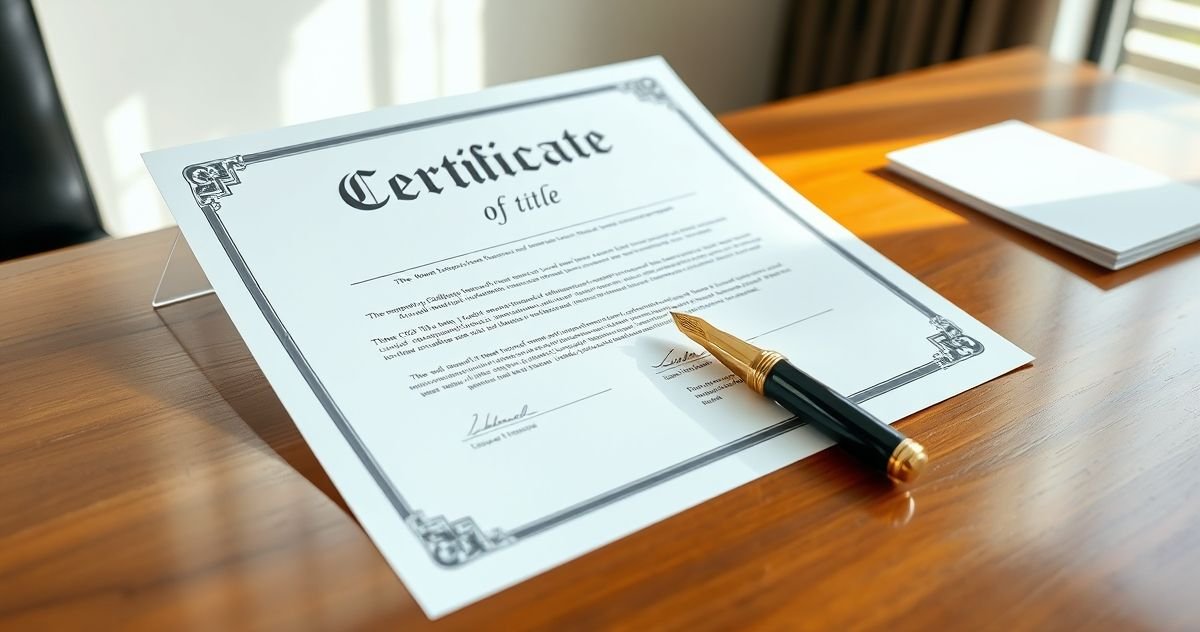A Certificate of Title Form is an essential legal document used primarily in the United States to establish and prove ownership of valuable assets such as vehicles, boats, and real estate. Issued by government agencies like a state’s Department of Motor Vehicles (DMV) or county recorder’s office, this document functions as the formal proof of legal title to an asset.
Purpose and Importance
The Certificate of Title serves three critical roles:
-
Proof of Ownership: It identifies the legal owner(s) of the asset, specifying unique details such as the Vehicle Identification Number (VIN) for vehicles or legal property descriptions for real estate. This confirms who has the right to possess, use, and transfer the asset.
-
Lienholder Information: If the asset was purchased with financing, the lender (bank, credit union, etc.) will be listed as a lienholder on the title, indicating a secured financial interest until the loan is paid off. After full repayment, the lienholder issues a release, allowing the owner to obtain a “clear” title.
-
Ownership Transfer: When an asset is sold or transferred, the Certificate of Title Form must be signed over to the new owner, legally recording the change in ownership with the relevant government office. This process prevents ownership disputes and fraud.
Common Types of Certificates of Title
- Vehicles: Cars, motorcycles, boats, RVs, and other motorized vehicles almost always require a Certificate of Title. The document details the make, model, VIN, ownership history, and any liens. This title is issued by a state’s DMV or equivalent agency.
- Real Estate: Ownership of land and buildings is normally evidenced by deeds rather than a “Certificate of Title Form” per se. However, deeds function similarly by conveying the title (legal ownership). Titles in real estate are typically recorded with a county recorder or land registry office.
Key Information Typically Found on a Certificate of Title
- Owner’s legal name(s)
- Asset description (VIN for vehicles, legal description for property)
- Title document number
- Issue date of the title
- Lienholder’s name if applicable
- Odometer reading for vehicles at the time of transfer (to help prevent fraud)
Important Tips for Handling Your Certificate of Title
- Store securely: Keep your title in a safe, secure place like a fireproof safe or safe deposit box to prevent loss or theft.
- Avoid laminating: Some states advise against laminating the title to preserve security features.
- Report loss promptly: If lost, contact your DMV immediately to apply for a duplicate title.
- Manage liens carefully: After paying off a loan, ensure your lienholder issues a release and obtain a clear title from the DMV.
- Transfer ownership promptly: When buying or selling, complete the title transfer quickly to avoid legal and registration issues.
Common Misconceptions
- A bill of sale alone doesn’t convey legal ownership without a title transfer.
- Ownership transfer usually requires notarization or DMV processing beyond merely signing the title.
- Clearing a lien requires official release and title update by the DMV.
Frequently Asked Questions
Q: Is the Certificate of Title the same as vehicle registration?
A: No. Title proves ownership; registration allows legal use of the vehicle on roads.
Q: How do I replace a lost title?
A: Request a duplicate from your state’s DMV by submitting the required forms and paying the fee.
Q: How to get a clear title after loan payoff?
A: Obtain a lien release from your lender and submit it with your current title to the DMV for a clear title.
Q: Can I sell a vehicle without a title?
A: Generally no; a title is required for legal ownership transfer in almost all states.
For more detailed guidance on vehicle ownership and title management, visit the USA.gov Vehicle Titles page or consult your local DMV.
Related FinHelp articles:
(Source: USA.gov, Consumer Financial Protection Bureau, IRS Publication 9465)






